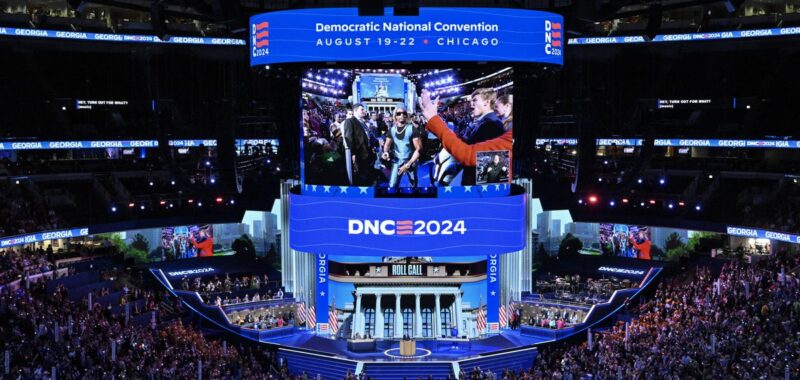Compare clips from the Democratic National Convention, which kicked off on Monday in Chicago, to the Republican National Convention in July. They feel like different universes.
At the RNC, during the roll call of votes nominating Donald Trump, states were called out to scattered applause along with the number of votes. The room was mostly quiet, and it sounded more like a jury delivering bad news than it did a political party affirming its future.
The DNC roll call, meanwhile, included a playlist of music related to each state, like “Sweet Home Alabama” for Alabama and “Not Like Us” by Kendrick Lamar for his home state of California. Delegates huddled around microphones, screaming and cheering as they announced their support for Vice President Kamala Harris. Lil Jon emerged out of the crowd singing “Turn Down for What” like the Kool-Aid Man breaking through a wall. Compared to the almost somber energy at the RNC, the DNC is a party, and the Democrats are trying to make sure you know about it.
The Democrats are running with a straightforward strategy in the lead-up to November: flood the zone with content. This is happening against a fairly dire backdrop. According to a Democratic press release, night one of the DNC averaged 20 million viewers across 13 networks, down 22 percent from the 2016 convention when Hillary Clinton accepted her party’s nomination. The GOP is not faring much better: the RNC this year averaged even less, with 18 million viewers on its first evening. The gap is being filled by new platforms and new media. The Democrats say that 7 million people streamed the first night of the DNC, and content published by creators received 30 million views.
It’s not just political influencers in attendance, either. Some are lifestyle influencers whose outfit videos are now side by side with footage from the DNC. I read this as a sign of who they want to reach: not just people watching Hasan Piker streams but also the TikTok users who flock to the app to hear their favorite fashion influencer talk about their life. The party is hedging its bets that the message will travel farther — and perhaps penetrate apathy — if it comes from someone viewers trust for other topics.
The 2024 US presidential election until this point has been largely vibes-based: excitement on the left turned a corner literally overnight after President Joe Biden announced he would not seek reelection. But politics has always been at least partially informed by vibes — before voters were asking about whether Tim Walz is “Midwest Princess,” they were debating which candidate they’d rather have a beer with. What the Harris campaign has done so effectively is to keep her at the top of people’s minds through savvy marketing that co-opts the type of content that people are already consuming online.
And what better way to do that than to somehow license more than 50 ultrapopular songs and use them, essentially, as hype-up music? The move has spawned countless posts on platforms like X and TikTok, creating a social media moment out of something that otherwise might be a boring formality. It’s one thing to have the influencers you invited make mildly cringey videos about your convention — anyone can throw money at paid media. But it’s this wave of organic, unpaid content that is actually notable. Ask anyone in marketing: that earned media is priceless.

